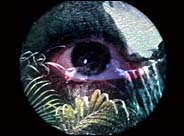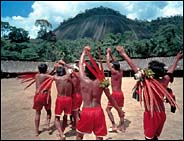Artists Touched by Amazon Tribe. From "Yanomami: The Spirit of the Forest.
By ALAN RIDING
Images from "Yanomami: The Spirit of the Forest," in which 12 Western artists seek to illuminate the creative processes of the Yanomami Indians.



PARIS — The Yanomami are probably the last example of the myriad Indian tribes that once lived in isolated harmony with the tropical forests of the Amazon Basin. As such, devoted to hunting and fishing and governed by powerful spirits, their natural — and naked — way of life has come to be viewed with Rousseau-like nostalgia by many Western anthropologists.
That the Yanomami have survived is itself remarkable. They first came into contact with Westerners in the early 20th century. By midcentury Catholic and Protestant missions had settled in their territory. In the 1980's their lands were invaded by gold prospectors, who polluted their rivers and introduced contagious diseases. Finally, in 1992, in response to an international campaign, the Brazilian government granted them 37,000 square miles of forest as a reserve.
Through all this they preserved their language, rituals and customs. And it is this that has inspired an unusual exhibition at the Cartier Foundation of Contemporary Art in Paris: "Yanomami: The Spirit of the Forest," which runs through Oct. 12. The exhibition is not an ethnographic show. Rather it is an attempt to explore the parallels between the imagination of the Yanomami and the creative process of Western artists.
The focus is on the community of Watoriki, 127 strong, one of at least 185 villages that account for the 12,500 Yanomami in Brazil. (Another 14,000 live in more precarious circumstances in Venezuela.) Bruce Albert, a French anthropologist who has worked among the Yanomami since the 1970's, and Davi Kopenawa, a Yanomami spokesman who speaks Portuguese as well as his native language, provided the bridge between Paris and Watoriki.
Late last year 5 of the 12 artists in this show traveled to Watoriki to work alongside the Yanomami. Three others worked with material brought from the region, and the final four are presenting photographs and films recorded among the Yanomami in earlier years. The result is an intimate view of the daily life and religious ceremonies of the Yanomami as well as a Western interpretation of their perception of the world.
Mr. Kopenawa, who was in Paris for the opening of the exhibition, said the initiative gave the Yanomami a chance to shape their own image. "You don't know our forests and houses," he explained. "You don't understand our words. We could even end up disappearing without you realizing. That's why, if we remain forgotten by you like turtles hidden in the soil of the forest, I think we will suffer."
He said that the whites in the Yanomami region — soldiers, cattle ranchers and miners — are hostile to them. Even those who come to photograph them leave no benefits for the Indians, he added. "The whites take pictures of the plants, animals, forests, us, then go away with their pictures," he went on. "We think that people who see this exhibition can understand us better and say, `Yes, the Yanomami have always protected their forest.' "
At the center of tribal life stands the shaman or, in the case of Watoriki, no fewer than a dozen shamans, men who sniff the hallucinogenic powder yakoana to commune with spirits that heal the sick and watch over the life of the forest. And it is through the shamans that the Yanomami learn to share an inner world where Omama, the creator of the universe, is in a constant struggle against his evil brother, Yoasi.
It is with this world that some artists in the Cartier Foundation show have tried to engage. Raymond Depardon, a French artist, has made a 32-minute film; along with scenes of hunting and fishing, it portrays Yanomami shamans consuming yakoana. Gary Hill, the American video artist and the only visitor to try yakoana himself, has reinterpreted the experience in a video that shows him hanging upside down mumbling incoherently.
Two artists who did not visit Watoriki have also tried to recreate the Yanomami imagination. In "Mirror Maze (Dead Eyes Live)," Tony Oursler, another American video artist, has projected close-ups of eyes onto eight large white balls; behind each blinking eye can be seen animals drawn by young Indians and scenes of shaman sessions filmed by a Yanomami. Vincent Beaurin, a French sculptor, has reinterpreted Yanomami cosmology in a series of bizarre abstract forms.